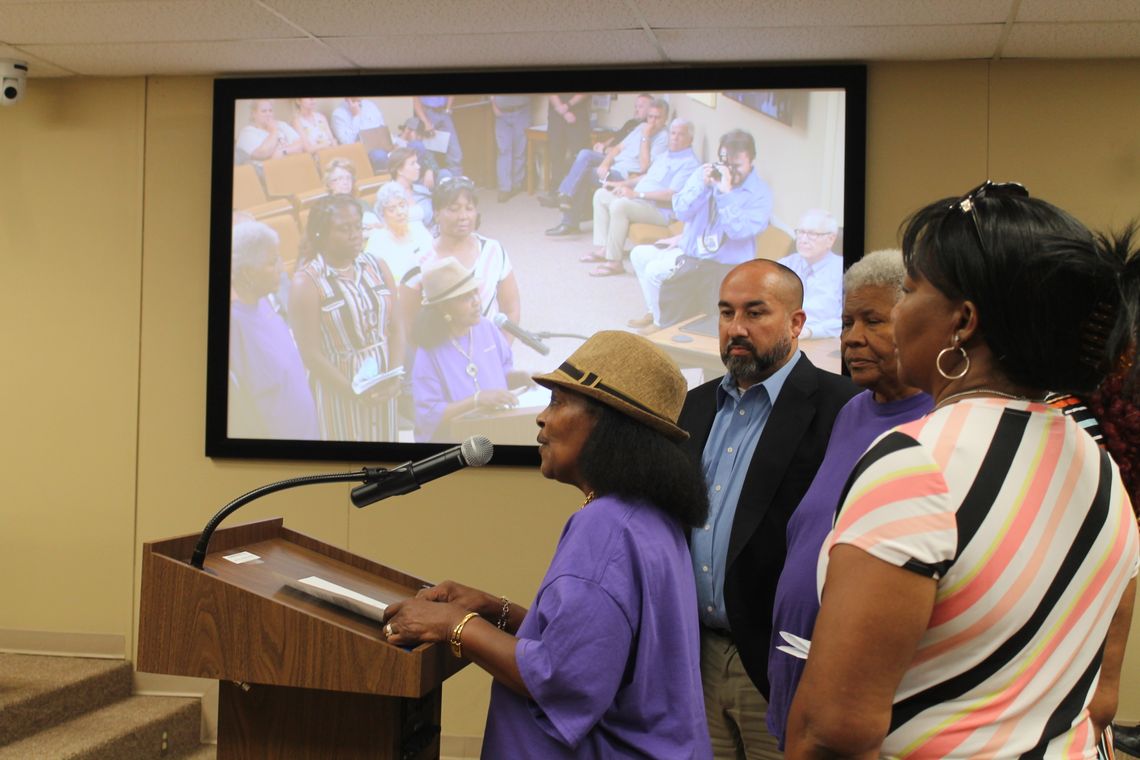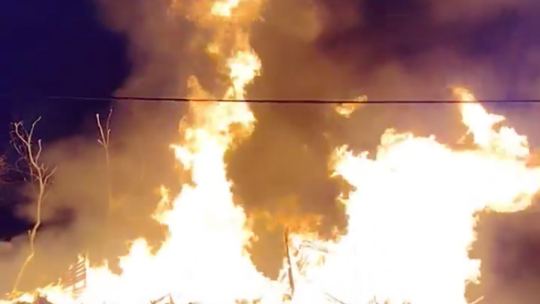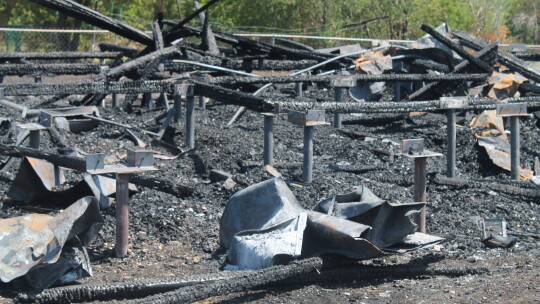Dr. James Lee Dickey’s home is destroyed, but a replica could help keep a legacy still very well intact in residents’ heart.
Jennifer Harris, Dickey Museum and Multipurpose Center board president, is calling for Taylor’s help to replicate the historic home that recently burned down. Harris and board members made her plea at the Taylor City Council meeting Thursday, July 15.
“We stand here this evening to ask of the city and the community of Taylor if they would join in our efforts to recreate the replica of the building that was so tragically destroyed on this past Sunday,” said Harris.
Harris thanked first responders and “the many, many people you never knew who cares until times like these.”
“I have received words of encouragement, support and love,” she said, “and we just say thank you.”
Plans were in place to turn the building into the Dickey Museum and Multipurpose Center, which was to provide information about African-Americans and the contributions they made to Taylor and the U.S. It would also serve as a resource to teach African-American history through interactive and engaging exhibits.
The master site plan included a theater space, a meeting room, a wellness center, mediation area, playscape, basketball courts and a trail surrounding the museum that would connect to the city’s hike and bike trail. The total cost of the project was $508,000.
The museum broke ground in January 2016 and has been in ongoing phases of renovation while encountering previous setbacks as well. According to Harris, the home was in the final stages of renovation and was targeted to open next summer .
“We’re going to move forward and still meet our goal of July 2023,” said Harris.
The tragedy
On July 10, the Taylor Fire Department and other area firefighters responded to the 500 block of Burkett Street for a fire that engulfed the historic home.
According to the Taylor Fire Department, at 3:32 a.m., firefighters responded to a call regarding a structure fire. When they arrived around 3:40 a.m., firefighters found the historic former home of Dickey fully engulfed in flames. Fire crews from Taylor, Round Rock, the Hutto Emergency Services District (ESD), firefighters from ESD 10 in Coupland and Thrall, and volunteers from the Avery-Pickett Volunteer Fire Department attempted to contain the fire, but the structure was burned to the ground.
“I would like to extend my gratitude to the firefighters at the Taylor Fire Department and our neighboring communities,” said Mayor Brandt Rydell, “for their work in extinguishing the flames and keeping the fire from spreading.”
The fire was extinguished around 4:45 a.m. Firefighters were also able to extinguish a small grass fire that started as a result of the incident.
Mike Fish, who lives across the street from the Dickey home, sprayed water throughout his property to keep it from going up in flames as well.
“The roof of my shed was smoking quite a lot. It looked as though my home here was (on fire), especially the fence here, a lot of smoke, looks like it was about to burn,” said Fish, who called the incident a sad passing of Taylor history. “I hope their legacy does continue on in other ways. I was looking forward to that being a museum. Mr. Dickey looked to be a very good man. This is a sad day in Taylor.”
‘Why would someone do this?’
After the fire was extinguished, the State Fire Marshal and Taylor Police Department detectives were called to the scene to assist with the investigation of the incident. The Fire Marshal found no evidence that accelerants were used, but police considered the incident suspicious.
Two days later, Tuesday, July 12, police arrested James Paul Gogolewski, 47, of Taylor, and charged him with arson, a second-degree felony.
According to the arrest affidavit, Gogolewski told his father he “had to burn down that Pagan church.” The Dickey home and future museum was never a church of any kind.
On Saturday, July 9, at 11:42 p.m., officers responded to a call for suspicious circumstances in the 1700 block of Mallard Lane. Gogolewski’s mother told police he left with a can of butane fuel. Officers did not locate him at the time.
Later that night, an officer saw Gogolewski under the bridge in the 1300 block of north Main Street, but quickly lost sight of him.
According to the affidavit, Gogolewski was spotted about a block away from the fire and was questioned by police. Officers noticed his hand was freshly cut. He told police he did not know how he cut himself, and that he was just walking.
The affidavit said Gogolewski was “answering questions that were asked of him with strange answers.”
When asked if he had any weapons, Gogolewski said no. He then pulled out an orange torch lighter, a broken glass pipe and pieces of paper. Gogolewski was later released from the scene.
According to the affidavit, later that morning, Gogolewski went home and asked his father for a ride to pick up his belongings. His father said Gogolewski smelled like smoke as if he had been near a wood fire.
Gogolewski directed his father to the area of the fire, and Gogolewski went towards the trees behind the former museum. He returned with a few clothes and some rocks.
As they passed the remains of the museum, Gogolewski said, “I had to burn down that Pagan church,” according to the affidavit.
Gogolewski’s father asked if he burned the building and Gogolewski responded, “Yes, it was a Pagan church and I had to burn it down.” The affidavit said
The affidavit said later that day while eating, Gogolewski’s mother heard him say, “I burned down that Pagan church. I had to.”
Gogolewski was charged with arson, a second-degree felony. If convicted, he could face up to $10,000 in fines, up to 20 years in prison or both.
“I don’t hold any malice in my heart,” said Harris before a suspect was announced. “I was angry at first, but I’m no longer angry at this person and I forgive them for what they have done.”
Inflammable legacy
As one of Taylor’s notable residents, Dickey was one of 130 African American doctors in Texas and the first African American physician in Williamson County when he came to practice from the 1940s to 1950s. Outside of his office, Dickey’s pursuits included advocating for education, civil rights and other local ventures.
“To me, (Dr. Dickey) was like the Martin Luther King of Taylor,” Harris said. “He was the voice. He was a physician, he was a humanitarian and he fought for civil rights for the Taylor African Americans.”
Dr. Dickey’s home was the only structure left in the city that tied to his legacy.
Mayor Brandt Rydell said Dr. Dickey’s legacy lives large among the giants of Taylor.
“While it was tragic that we lost this important piece of history in Dr. Dickey’s former residence, his legacy is far more that a wood frame house,” Rydell said. “Dr. Dickey very much is living on in the hearts of this community. His memory will not die.”
Rydell said despite the setback of losing the building, the community will still move forward collectively to realize Dr. Dickey’s legacy and carry it forward with future generations.
Harris said she does not look at the loss of the house as the work and purpose of the board being destroyed.
“We are much alive, and as long as we’re here to preserve his history, then we’re going to continue to do that,” she said.







